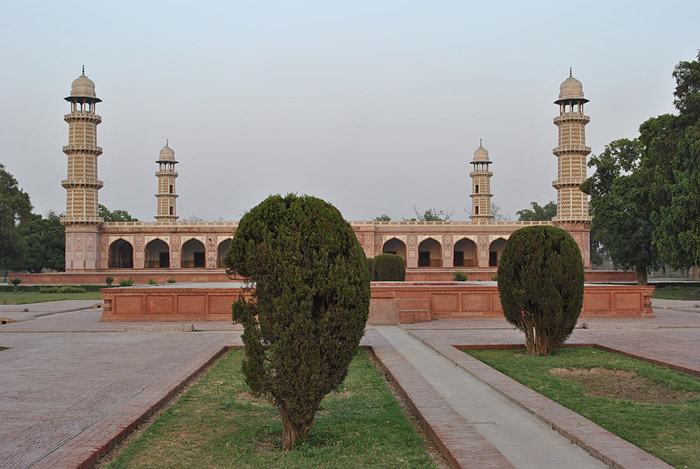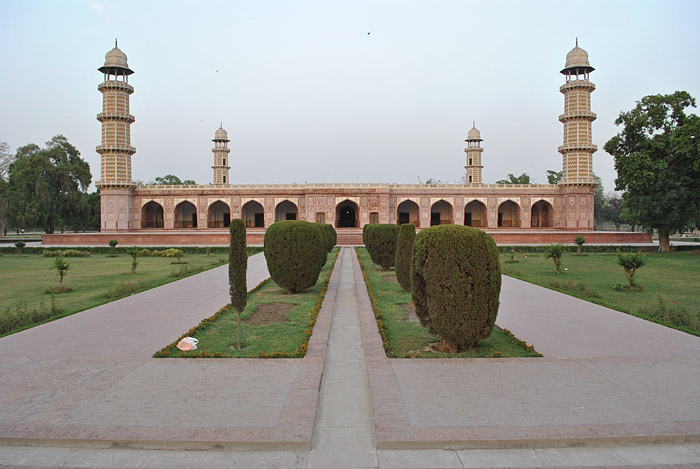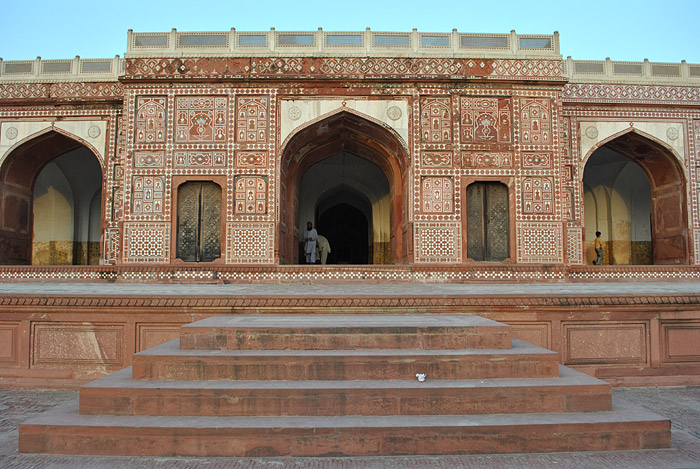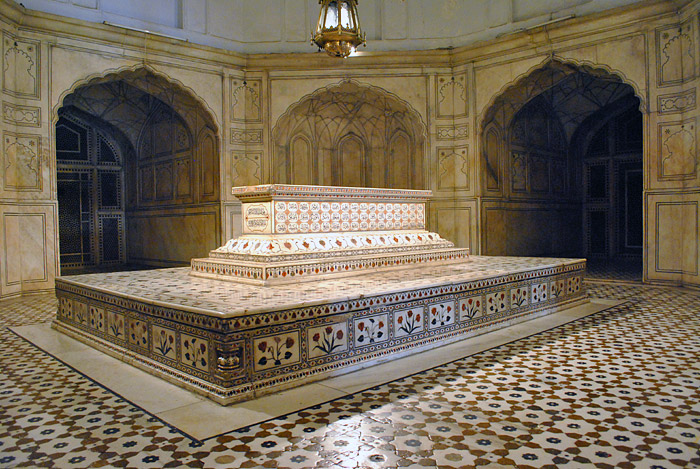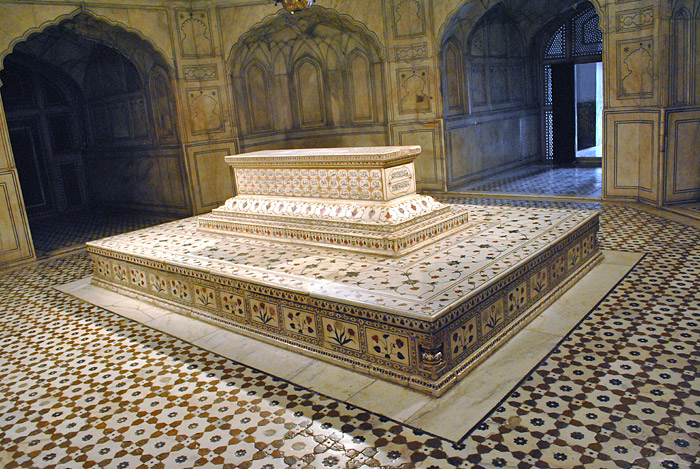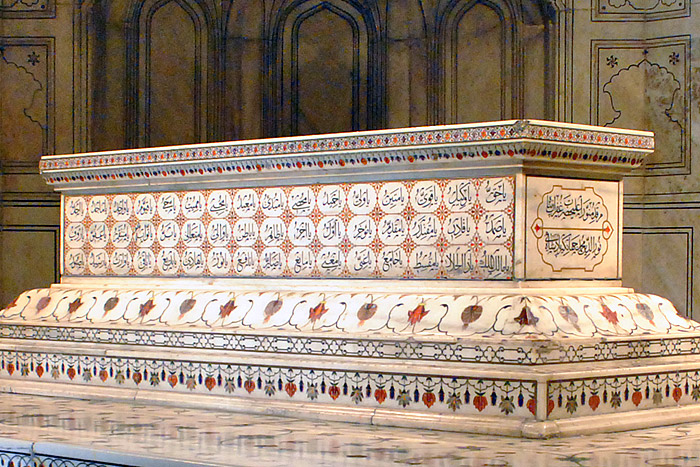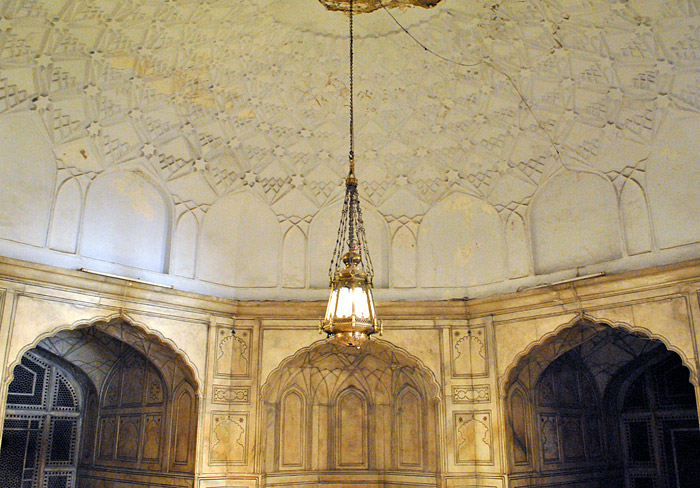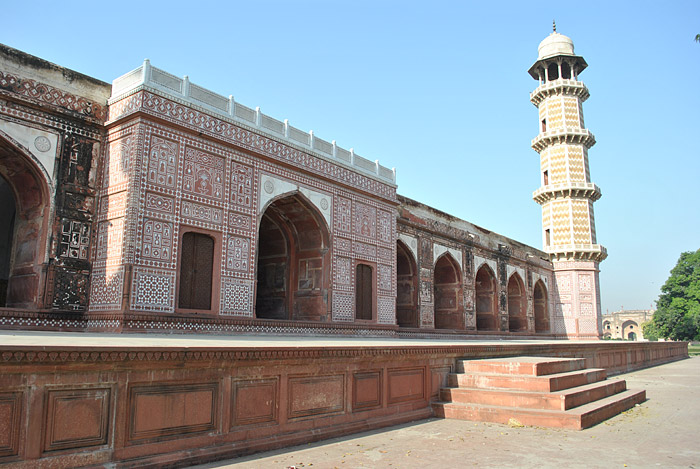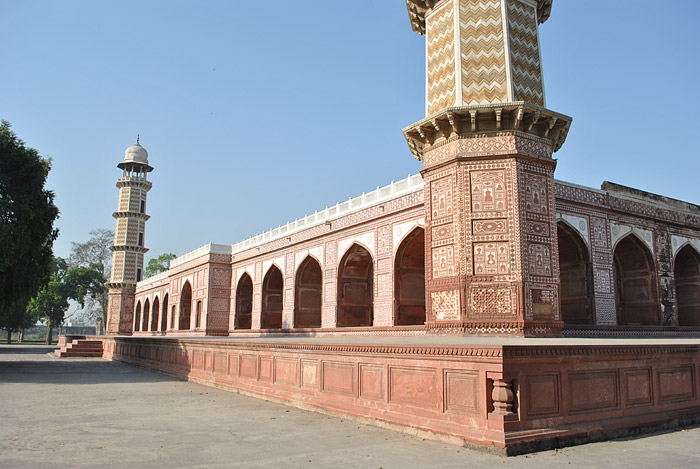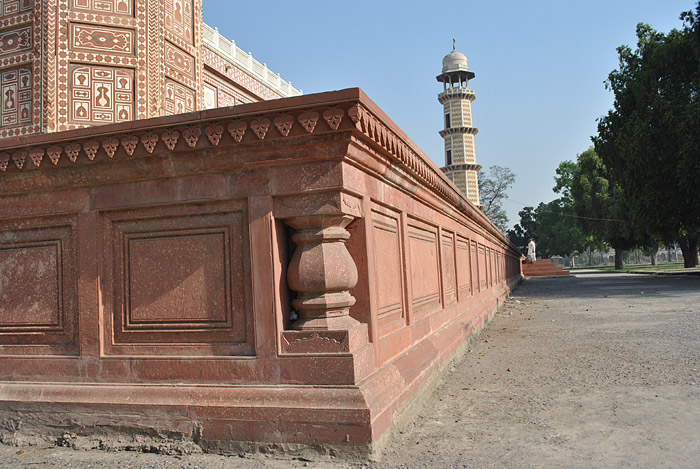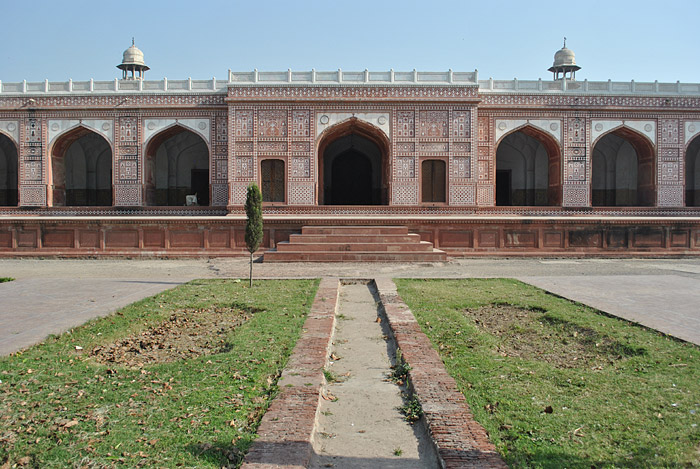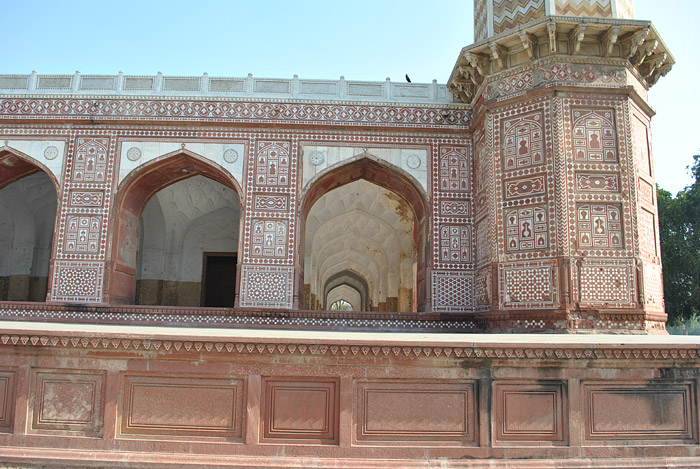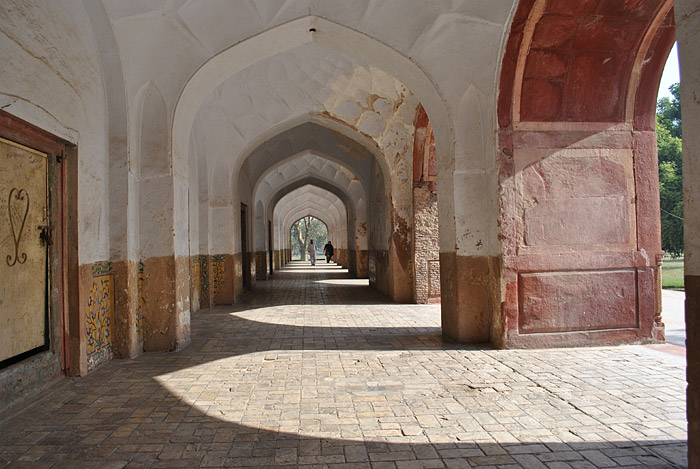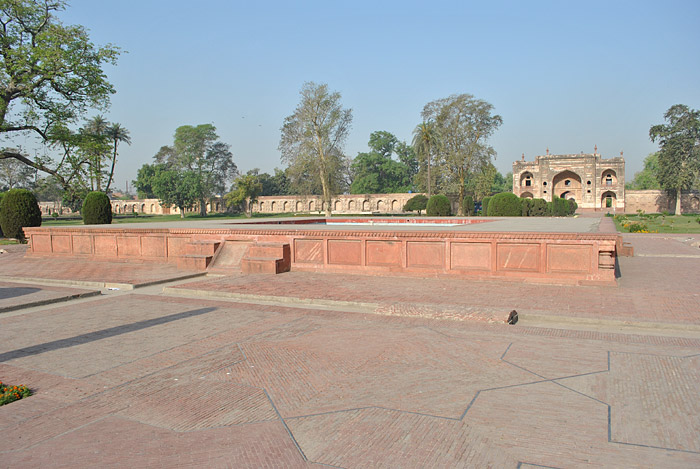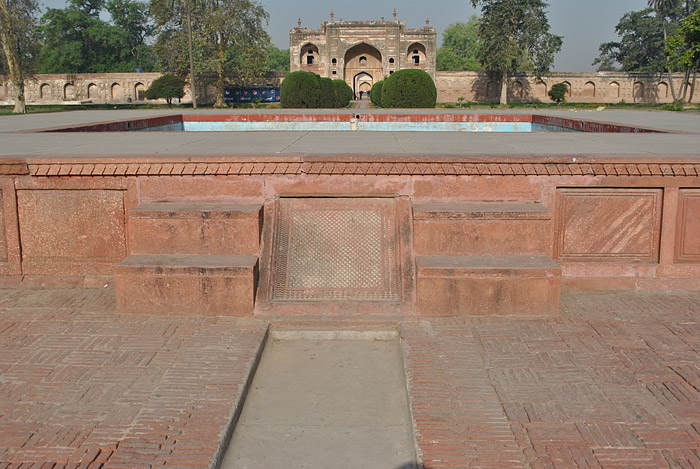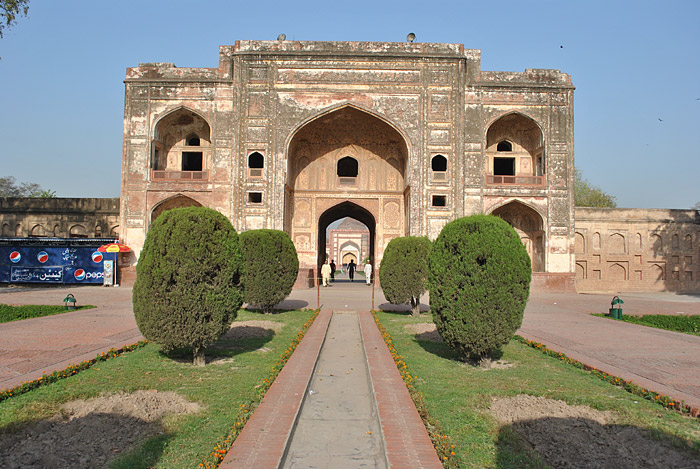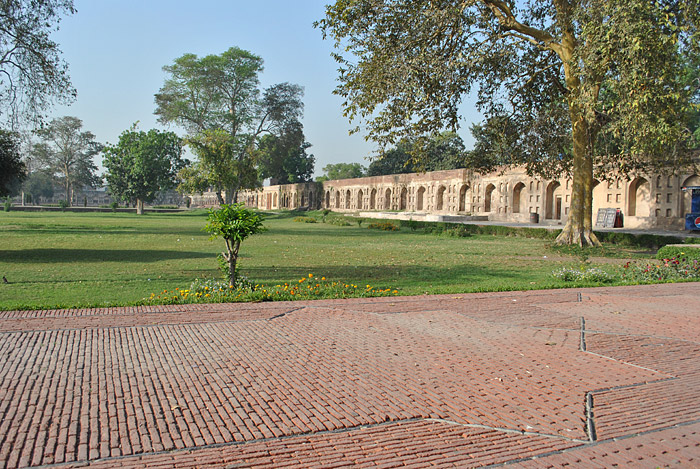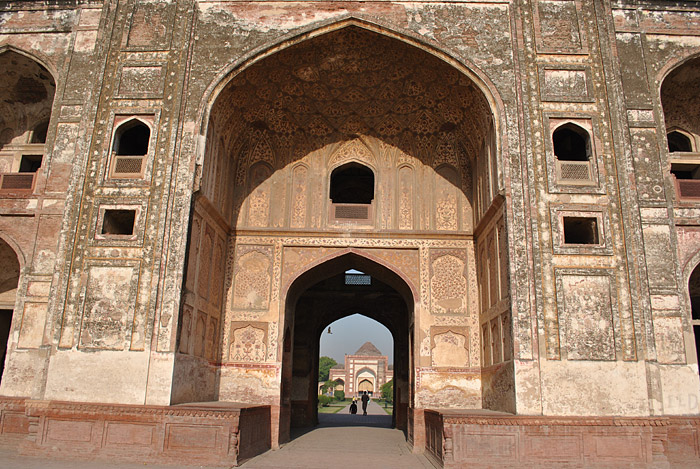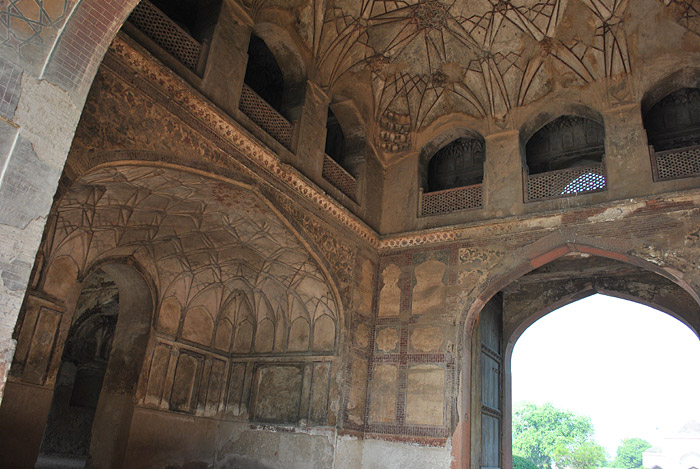Lahore Jahangir's Tomb
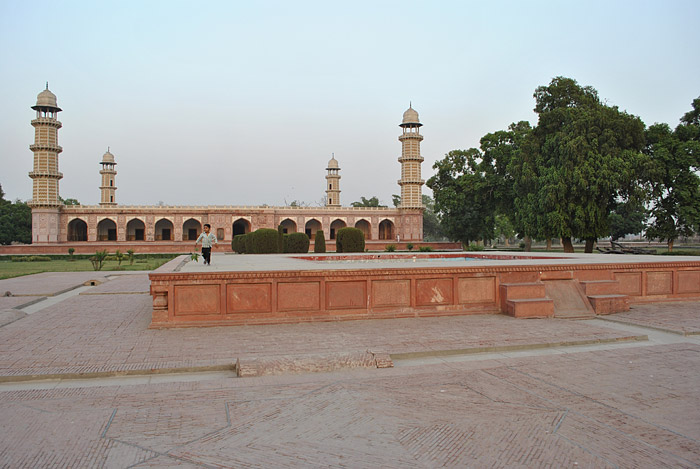
La tumba de Jahangir se encuentra en Shahdara, un suburbio de Lahore al noroeste de la ciudad. El área había sido un lugar favorito de Jahangir y su esposa Nur Jahan cuando residían en Lahore, y el área se usaba comúnmente como punto de partida para viajes hacia y desde Cachemira y Lahore. Cuando Jahangir murió en 1627, es posible que inicialmente haya sido enterrado en Shahdara en uno de sus muchos jardines. Su hijo, Shah Jahan, ordenó que se construyera un mausoleo digno de un emperador como monumento permanente.
La construcción del mausoleo duró 10 años, de 1627 a 37, y probablemente fue financiada por el tesoro imperial (aunque hay alguna evidencia de que la esposa de Jahangir, Nur Jahan, pudo haber financiado la construcción). Ocupa un vasto cuadrilátero que mide 600 gaz (aproximadamente 500 metros) a un lado y se subdivide en cuatro chahar baghs (jardines de cuatro partes). Una fuente ocupa el centro de cada uno de los chahar baghs y las avenidas intermedias, creando un anillo de 8 fuentes alrededor de la tumba central. El agua para las fuentes se suministró por pozos fuera del jardín y se elevó a canales en la parte superior de las paredes utilizando ruedas de agua que ya no existen. Desde allí, el agua fluía a través de tuberías de terracota y hacia las fuentes, después de lo cual el agua caía en cascada en canales poco profundos que recorrían todo el jardín.
El mausoleo en sí es de planta cuadrada y exactamente 100 gaz de lado. A excepción de los cuatro minaretes de las esquinas, el diseño es completamente horizontal con un techo plano que cubre toda la estructura. Es probable que esto se derive del ejemplo dado por el abuelo de Jahangir, Babur, quien prefirió el entierro en una tumba abierta al cielo de acuerdo con el precidente del Islam sunita. Tanto Jahangir como Shah Jahan habrían estado familiarizados con el jardín de la tumba de Babur en Kabul en el que se llevaron a cabo los deseos de Babur: se erigió una pantalla alrededor de la tumba, pero el cenotafio no estaba techado. En la tumba de Jahangir, se llegó a una especie de compromiso levantando un techo sobre el cenotafio, pero sin construir adornos monumentales como cúpulas. Este diseño aparentemente no fue muy popular, ya que fue replicado solo una vez para la tumba de Nur Jahan, la esposa de Jahangir, en el jardín de su tumba también en Shahdara. El propio Shah Jahan fue enterrado en el Taj Mahal, un monumento famoso por el uso de cúpulas como elementos arquitectónicos.
En el centro del mausoleo hay una cámara sepulcral octogonal de unos 8 metros de diámetro. Está conectado con el exterior de la tumba por cuatro pasillos que dan a los cuatro puntos cardinales. El cenotafio en el centro está tallado en una sola losa de mármol blanco y decorado con incrustaciones de pietra dura de los 99 atributos de Dios. A su pie hay una inscripción en persa que dice "Esta es la tumba iluminada de Su Majestad, el Asilo del Perdón, Nooruddin Muhammad Jahangir Padshah 1037 AH".
El establecimiento de la tumba de Jahangir en Shahdara afectó profundamente el carácter del suburbio. Mientras que anteriormente el área se había utilizado como un lugar de relajación, durante la época de Shah Jahan el suburbio se transformó en un monumento al gobierno imperial de Mughal. Esto solo se vio reforzado por la construcción de un jilau khana (patio delantero) al oeste de la tumba y la posterior construcción de una tumba para el ministro principal de Jahangir, Asaf Khan, al oeste. El conjunto alcanzó su punto máximo cuando la propia Nur Jahan fue enterrada en una tumba ligeramente al suroeste de las otras tumbas.
Hoy en día, la tumba de Jahangir tiene un significado especial para los paquistaníes, ya que es la única tumba mogol ubicada en el Pakistán actual. Su imagen aparece en el billete de 1.000 rupias y sigue siendo una de las atracciones más populares de Lahore.
The tomb of Jahangir is located in Shahdara, a suburb of Lahore to the northwest of the city. The area had been a favorite spot of Jahangir and his wife Nur Jahan when they resided in Lahore, and the area was commonly used as a point of departure for travels to and from Kashmir and Lahore. When Jahangir died in 1627 he may have initially been buried in Shahdara in one of its many gardens. His son, Shah Jahan, ordered that a mausoleum befitting an Emperor be built as a permanent memorial.
Construction of the mausoleum lasted 10 years, from 1627 to 37, and was probably funded by the imperial treasury (though there is some evidence that Jahangir's wife, Nur Jahan, may have financed the construction). It occupies a vast quadrangle measuring 600 gaz (approximately 500 meters) to a side and is subdivided into four chahar baghs (four-part gardens). A fountain occupies the center of each of the chahar baghs and the avenues in between, creating a ring of 8 fountains around the central tomb. Water for the fountains was supplied by wells outside of the garden and raised into channels atop of the walls using water wheels that are no longer extant. From there, the water flowed through terra cotta pipes and into the fountains, whereupon the water cascaded into shallow channels running throughout the garden.
The mausoleum itself is square in plan and exactly 100 gaz to a side. Except for the four corner minarets the layout is entirely horizontal with a flat roof covering the whole of the structure. It is likely that this derived from the example set by Jahangir's grandfather, Babur, who preferred burial in a tomb open to the sky in keeping with Sunni Islam precident. Both Jahangir and Shah Jahan would have been familiar with Babur's tomb garden in Kabul in which Babur's wishes were carried out--a screen was erected around the grave site but the cenotaph was not roofed over. At Jahangir's tomb, a compromise of sorts was arrived at by raising a roof over the cenotaph but not constructing any monumental embellishments such as domes. This design was apparently not very popular as it was replicated only once for the tomb of Nur Jahan, Jahangir's wife, at her tomb garden also in Shahdara. Shah Jahan himself was buried in the Taj Mahal, a monument renowned for its use of domes as architectural elements.
At the center of the mausoleum is an octagonal tomb chamber about 8 meters in diameter. It is connected to the outside of the tomb by four hallways facing the four cardinal directions. The cenotaph at the center is carved from a single slab of white marble and decorated with pietra dura inlays of the 99 attributes of God. At its foot is an inscription in Persian recording that "This is the illuminated grave of His Majesty, the Asylum of Pardon, Nooruddin Muhammad Jahangir Padshah 1037 AH".
The establishment of Jahangir's tomb at Shahdara profoundly affected the character of the suburb. Whereas previously the area has been used as a place of relaxation, during Shah Jahan's time the suburb was transformed into a monument to the Mughal's imperial rule. This was only strengthened by the construction of a jilau khana (forecourt) to the west of the tomb and the subsequent construction of a tomb to Jahangir's chief minister Asaf Khan to the west. The ensemble reached its peak when Nur Jahan herself was laid to rest in a tomb slightly to the southwest of the other tombs.
Today, the tomb of Jahangir holds special significance for Pakistanis as it is the only Mughal tomb located in present-day Pakistan. Its image appears on the 1,000 rupee banknote and it remains one of Lahore's most popular attractions.
